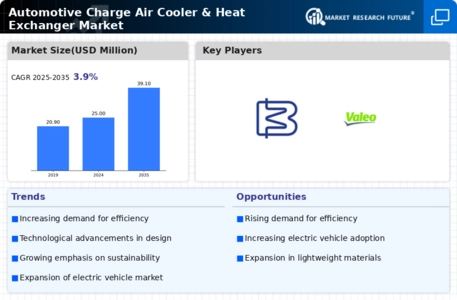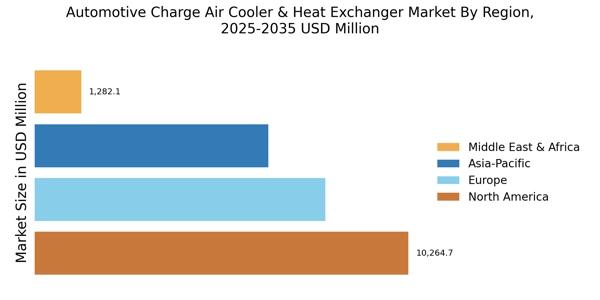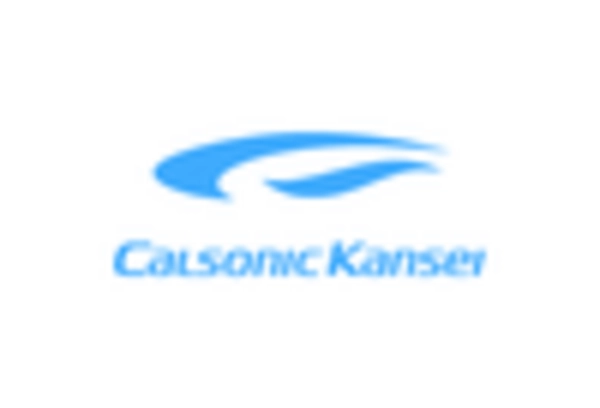Growth of the Automotive Sector
The Automotive Charge Air Cooler & Heat Exchanger Market is poised for growth, driven by the overall expansion of the automotive sector. As vehicle production ramps up, particularly in emerging markets, the demand for efficient cooling systems is expected to rise correspondingly. The automotive industry has seen a resurgence in vehicle sales, with projections indicating a steady increase in production rates. This growth is likely to stimulate the need for charge air coolers and heat exchangers, as manufacturers strive to enhance vehicle performance and meet consumer expectations. Furthermore, the trend towards turbocharged engines, which require effective cooling solutions, further supports this market expansion, suggesting a favorable outlook for manufacturers in the coming years.
Increasing Demand for Fuel Efficiency
The Automotive Charge Air Cooler & Heat Exchanger Market is experiencing a notable surge in demand for fuel-efficient vehicles. As consumers become more environmentally conscious, manufacturers are compelled to enhance engine performance while minimizing fuel consumption. Charge air coolers play a crucial role in this context, as they improve the efficiency of turbocharged engines by cooling the intake air, thereby increasing power output without additional fuel usage. According to recent data, the market for charge air coolers is projected to grow at a compound annual growth rate of approximately 5.2% over the next few years, driven by this emphasis on fuel efficiency. This trend indicates a robust opportunity for manufacturers to innovate and develop advanced cooling technologies that align with consumer preferences for sustainability.
Rising Popularity of Turbocharged Engines
The Automotive Charge Air Cooler & Heat Exchanger Market is experiencing a surge in demand due to the rising popularity of turbocharged engines. These engines, known for their ability to deliver higher power outputs while maintaining fuel efficiency, rely heavily on effective cooling systems to optimize performance. Charge air coolers are essential in this context, as they cool the compressed air before it enters the engine, enhancing combustion efficiency. The trend towards turbocharging is evident in various vehicle segments, including passenger cars and light trucks, with many manufacturers adopting this technology to meet consumer demands for performance. This shift is likely to bolster the market for charge air coolers, as the automotive industry continues to embrace turbocharged engine designs.
Regulatory Compliance and Emission Standards
The Automotive Charge Air Cooler & Heat Exchanger Market is significantly influenced by stringent regulatory frameworks aimed at reducing vehicular emissions. Governments worldwide are implementing increasingly rigorous emission standards, compelling automotive manufacturers to adopt technologies that enhance engine efficiency and reduce pollutants. Charge air coolers are integral to this effort, as they facilitate better combustion and lower exhaust emissions. For instance, the introduction of Euro 6 standards in Europe has necessitated the incorporation of advanced cooling systems in new vehicle models. This regulatory pressure is likely to drive the demand for high-performance charge air coolers, as manufacturers seek to comply with these evolving standards while maintaining competitive performance metrics.
Technological Innovations in Cooling Systems
The Automotive Charge Air Cooler & Heat Exchanger Market is benefiting from rapid technological advancements in cooling systems. Innovations such as lightweight materials, enhanced heat transfer technologies, and compact designs are revolutionizing the performance of charge air coolers. These advancements not only improve the efficiency of cooling systems but also contribute to overall vehicle weight reduction, which is a critical factor in enhancing fuel efficiency. Manufacturers are increasingly investing in research and development to create next-generation cooling solutions that meet the demands of modern engines. This focus on innovation is likely to drive market growth, as consumers and manufacturers alike seek high-performance, reliable cooling systems that can withstand the rigors of contemporary automotive applications.


















Leave a Comment